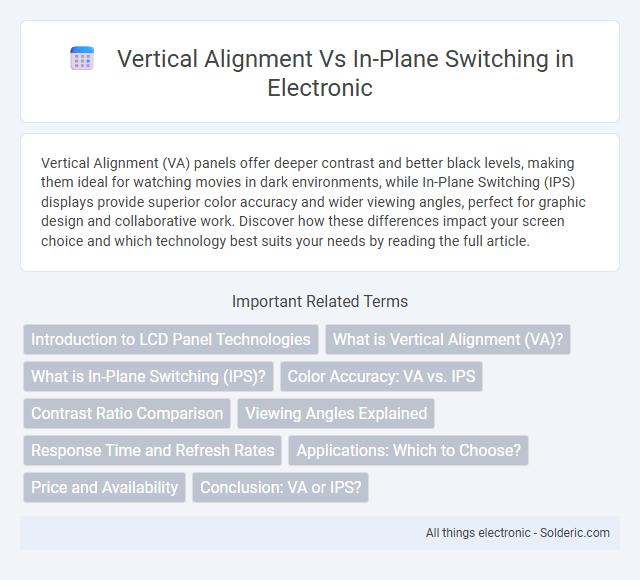Vertical Alignment (VA) panels offer deeper contrast and better black levels, making them ideal for watching movies in dark environments, while In-Plane Switching (IPS) displays provide superior color accuracy and wider viewing angles, perfect for graphic design and collaborative work. Discover how these differences impact your screen choice and which technology best suits your needs by reading the full article.
Comparison Table
| Feature | Vertical Alignment (VA) | In-Plane Switching (IPS) |
|---|---|---|
| Viewing Angles | Narrower, typically 130deg-160deg | Wide, up to 178deg |
| Contrast Ratio | High, often 3000:1 or greater | Lower, around 1000:1 to 1500:1 |
| Color Accuracy | Good, but less vibrant | Excellent, vibrant and accurate |
| Response Time | Moderate, 4-8 ms typical | Faster, often 1-4 ms |
| Black Levels | Superior, deeper blacks | Less deep blacks |
| Price | Generally lower cost | Typically higher cost |
| Ideal Use | Movies, general use with deep blacks | Graphic design, professional photo editing |
Introduction to LCD Panel Technologies
Vertical Alignment (VA) and In-Plane Switching (IPS) are two primary LCD panel technologies designed to enhance display performance. VA panels offer superior contrast ratios and deeper blacks due to liquid crystals aligning vertically when inactive, making them ideal for dark-room viewing. Your choice depends on preferences for color accuracy and viewing angles, where IPS panels excel by keeping crystals aligned horizontally for consistent image quality across wider angles.
What is Vertical Alignment (VA)?
Vertical Alignment (VA) technology features liquid crystals that align perpendicularly to the glass substrates, allowing deeper black levels and higher contrast ratios than In-Plane Switching (IPS) panels. VA panels typically achieve contrast ratios ranging from 2000:1 to 6000:1, making them ideal for darker environments and cinematic viewing. This alignment results in narrower viewing angles compared to IPS but superior color depth and contrast performance.
What is In-Plane Switching (IPS)?
In-Plane Switching (IPS) is a type of LCD technology known for superior color accuracy and wider viewing angles compared to Vertical Alignment (VA) panels. IPS panels use liquid crystals aligned parallel to the screen, allowing consistent color reproduction from different perspectives, making them ideal for graphic design and professional use. Your display's clarity and color integrity benefit significantly from IPS technology, especially in environments requiring precise visuals.
Color Accuracy: VA vs. IPS
IPS panels deliver superior color accuracy and wider viewing angles compared to VA panels, making them ideal for tasks requiring precise color representation like photo editing and graphic design. VA panels provide deeper blacks and higher contrast ratios but tend to have less accurate color reproduction and narrower viewing angles. Your choice depends on whether color fidelity or contrast is more critical for your display needs.
Contrast Ratio Comparison
Vertical Alignment (VA) panels typically offer higher contrast ratios, often ranging from 2000:1 to 6000:1, compared to In-Plane Switching (IPS) panels, which generally have contrast ratios around 1000:1. This higher contrast ratio in VA panels results in deeper blacks and more vivid dark scenes, making them ideal for watching movies and gaming in low-light conditions. IPS panels deliver superior color accuracy and viewing angles but sacrifice contrast performance, leading to slightly washed-out blacks in dark environments.
Viewing Angles Explained
Vertical Alignment (VA) panels offer superior contrast ratios but have narrower viewing angles, causing color and brightness shifts when viewed off-center. In-Plane Switching (IPS) technology delivers wider viewing angles with minimal distortion, maintaining color accuracy and brightness consistency across the screen. For environments requiring consistent image quality regardless of viewing position, IPS panels are the preferred choice due to their superior angular performance.
Response Time and Refresh Rates
Vertical Alignment (VA) panels generally offer slower response times compared to In-Plane Switching (IPS) panels, making IPS displays preferable for fast-moving visuals in gaming and video playback. Refresh rates on IPS panels tend to be higher and more consistent, supporting smoother motion and reduced ghosting effects during high-frame-rate content. VA panels often feature better contrast ratios but typically lag behind IPS technology in delivering rapid pixel transitions and maintaining stable refresh rates at peak performance.
Applications: Which to Choose?
Vertical Alignment (VA) panels excel in providing deeper blacks and higher contrast ratios, making them ideal for viewing environments where image clarity in dark scenes is critical, such as home theaters and graphic design. In-Plane Switching (IPS) displays offer superior color accuracy and wider viewing angles, preferred for professional photo editing, gaming, and collaborative workspaces requiring consistent color from multiple perspectives. Choosing between VA and IPS depends largely on whether the priority is high contrast and dark-room performance (VA) or color fidelity and extended viewing angles (IPS).
Price and Availability
Vertical Alignment (VA) panels typically offer more affordable prices while maintaining high contrast ratios, making them a cost-effective choice for budget-conscious buyers. In-Plane Switching (IPS) panels are generally more expensive due to advanced technology providing better color accuracy and wider viewing angles, but they are widely available across mid to high-end monitors and smartphones. Both panel types are readily accessible in the market, with VA panels dominating budget displays and IPS panels prevalent in premium devices.
Conclusion: VA or IPS?
Vertical Alignment (VA) panels offer higher contrast ratios and deeper blacks, making them ideal for watching movies in dark environments. In-Plane Switching (IPS) panels provide superior color accuracy and wider viewing angles, preferred for professional graphic work and gaming. Choosing between VA and IPS depends on prioritizing either richer contrast or color consistency and viewing angle.
Vertical Alignment vs In-Plane Switching Infographic

 solderic.com
solderic.com